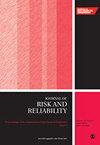基于改进峰值区域能量和多模型最小二乘支持向量数据描述的自主水下航行器推力器故障识别
IF 1.7
4区 工程技术
Q3 ENGINEERING, INDUSTRIAL
Proceedings of the Institution of Mechanical Engineers Part O-Journal of Risk and Reliability
Pub Date : 2022-11-30
DOI:10.1177/1748006x221139618
引用次数: 0
摘要
本文研究了一种新的故障识别方法来确定自主水下航行器推进器的推力损失百分比。该方法将峰值区域能量(PRE)和支持向量数据描述(SVDD)相结合,考虑到PRE无需二次处理即可从信号中获取低维主特征,而SVDD即使在训练样本数量较少的情况下也可以为一类故障样本建立超球边界。对PRE进行了去除融合、能量泄漏和同态变换的改进。它形成一个改进的PRE,以增加曲线下的面积。在此基础上,增加了最小二乘、多模型融合和盲区三个新内容。构建了多模型最小二乘SVDD,提高了整体识别精度。在水池中对实验原型自主水下航行器进行了实验研究。实验结果表明了该方法的有效性。本文章由计算机程序翻译,如有差异,请以英文原文为准。
Thruster fault identification using improved peak region energy and multiple model least square support vector data description for autonomous underwater vehicle
This article investigates a novel fault identification approach to determine the percentage of the thrust loss for autonomous underwater vehicle thrusters. The novel approach is developed from a combination of the peak region energy (PRE) and support vector data description (SVDD) by considering that PRE is able to acquire a primary feature in low dimensions from signals without any secondary process and that SVDD can establish a hypersphere boundary for a class of fault samples even in the case of a small number of training samples. Three improvements, namely removing the fusion, an energy leakage and a homomorphic transform are applied to the PRE. It forms an improved PRE to increase the area under the curve. Furthermore, another three new contents, namely the least square, a multiple model fusion and a dead zone are added to the SVDD. It constructs a multiple model least square SVDD to increase the overall identification accuracy. Experiments are performed on an experimental prototype autonomous underwater vehicle in a pool. The experimental results indicate the effectiveness of the proposed method.
求助全文
通过发布文献求助,成功后即可免费获取论文全文。
去求助
来源期刊

Proceedings of the Institution of Mechanical Engineers Part O-Journal of Risk and Reliability
ENGINEERING, MULTIDISCIPLINARY-ENGINEERING, INDUSTRIAL
CiteScore
4.50
自引率
19.00%
发文量
81
审稿时长
6-12 weeks
期刊介绍:
The Journal of Risk and Reliability is for researchers and practitioners who are involved in the field of risk analysis and reliability engineering. The remit of the Journal covers concepts, theories, principles, approaches, methods and models for the proper understanding, assessment, characterisation and management of the risk and reliability of engineering systems. The journal welcomes papers which are based on mathematical and probabilistic analysis, simulation and/or optimisation, as well as works highlighting conceptual and managerial issues. Papers that provide perspectives on current practices and methods, and how to improve these, are also welcome
 求助内容:
求助内容: 应助结果提醒方式:
应助结果提醒方式:


